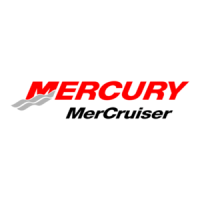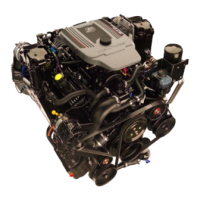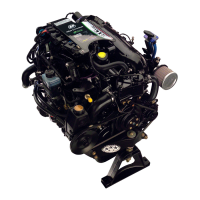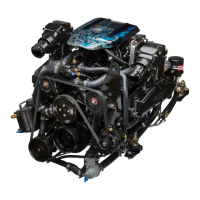MAINTENANCE - 1B - 590-816462 2-695
4 Cylinder
20-Hour Break-In Period
IMPORTANT: The first 20 hours of operation is the
engine break-in period. Correct break-in is essen-
tial to obtain minimum oil consumption and maxi-
mum engine performance. During this break-in
period, the following rules must be observed:
• Do not operate below 1500 RPM for extended pe-
riods of time for first 10 hours. Shift into gear as
soon as possible after starting and advance
throttle above 1500 RPM if conditions permit safe
operation.
• Do not operate at one speed consistently for ex-
tended periods.
• Do not exceed 3/4 throttle during first 10 hours.
During next 10 hours, occasional operation at full
throttle is permissible (5 minutes at a time maxi-
mum).
• Avoid full throttle acceleration from idle speed.
• Do not operate at full throttle until engine reaches
normal operating temperature.
• Frequently check crankcase oil level. Add oil if
needed. It is normal for oil consumption to be high
during break-in period.
• After 20-hour break-in period, drain crankcase oil
and replace oil filter (see “Maintenance”). Fill
crankcase with correct oil (see “Specifications”).
After 20 Hour Break-In Period
To help extend the life of your MerCruiser power
package, the following recommendations should be
considered:
• Use a propeller that allows the engine to operate at
or near the top of the maximum RPM range (See
Specifications) when at full throttle with a normal
boat load.
• Operation at 3/4 throttle setting or lower is recom-
mended. Refrain from prolonged operation at
maximum (full throttle) RPM.
20-Hour Checkup
After first 20 hours of operation, an Authorized Mer-
Cruiser Dealer should be contacted for the following
maintenance. The boat owner is responsible for any
charges.
• Change crankcase oil and filter.
• Check all fluid levels.
• Cooling Systems - Inspect all hoses for damage
and deterioration; check all hose clamps for ade-
quate tightness.
• Check carburetor adjustment.
• Inspect ignition system and timing.
• Check for loose, missing or damaged parts.
• Check shift and throttle cable adjustments - Lubri-
cate and inspect for loose, damaged or missing
parts.
• Steering System - Lubricate and inspect for loose,
damaged or missing parts.
• Inspect all drive belts.
• Check engine alignment.
• Complete Engine Exhaust System - Inspect exter-
nally for damage and deterioration; check all hose
clamps for adequate tightness.
• Front engine mounts-Tighten securely and ensure
that thejam nut is tight.
• Rear mounts-Check torque to 35-40 lb. ft. (47-54
N·m).
• Retorque gimbal ring clamping U-bolt to 55 lb. ft.
(74 N·m).

